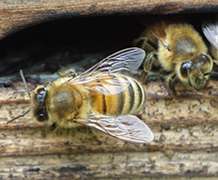Virtual bees help to unravel complex causes of colony decline

Scientists have created an ingenious computer model that simulates a honey bee colony over the course of several years.
The BEEHAVE model, published today in the Journal of Applied Ecology, was created to investigate the losses of honeybee colonies that have been reported in recent years and to identify the best course of action for improving honeybee health.
A team of scientists, led by Professor Juliet Osborne from the Environment and Sustainability Institute, University of Exeter (and previously at Rothamsted Research), developed BEEHAVE, which simulates the life of a colony including the queen's egg laying, brood care by nurse bees and foragers collecting nectar and pollen in a realistic landscape.
Professor Osborne said: "It is a real challenge to understand which factors are most important in affecting bee colony growth and survival. This is the first opportunity to simulate the effects of several factors together, such as food availability, mite infestation and disease, over realistic time scales."
The model allows researchers, beekeepers and anyone interested in bees, to predict colony development and honey production under different environmental conditions and beekeeping practices. To build the simulation, the scientists brought together existing honeybee research and data to develop a new model that integrated processes occurring inside and outside the hive.
The first results of the model show that colonies infested with a common parasitic mite (varroa) can be much more vulnerable to food shortages. Effects within the first year can be subtle and might be missed by beekeepers during routine management. But the model shows that these effects build up over subsequent years leading to eventual failure of the colony, if it was not given an effective varroa treatment.
BEEHAVE can also be used to investigate potential consequences of pesticide applications. For example, the BEEHAVE model can simulate the impact of increased loss of foragers. The results show that colonies may be more resilient to this forager loss than previously thought in the short-term, but effects may accumulate over years, especially when colonies are also limited by food supply.
BEEHAVE simulations show that good food sources close to the hive will make a real difference to the colony and that lack of forage over extended periods leaves them vulnerable to other environmental factors. Addressing forage availability is critical to maintaining healthy hives and colonies over the long term.
Professor Osborne added: "The use of this model by a variety of stakeholders could stimulate the development of new approaches to bee management, pesticide risk assessment and landscape management. The advantage is that each of these factors can be tested in a virtual environment in different combinations, before testing in the field. Whilst BEEHAVE is mathematically very complex, it has a user-friendly interface and a fully accessible manual so it can be explored and used by a large variety of interested people".
More information: BEEHAVE is freely available at www.beehave-model.net.
Journal information: Journal of Applied Ecology
Provided by University of Exeter


















